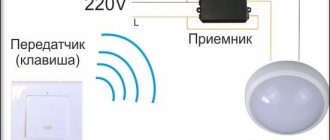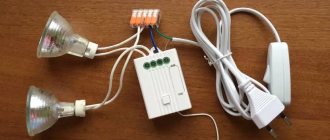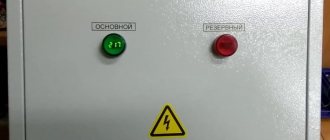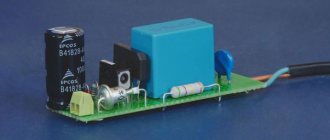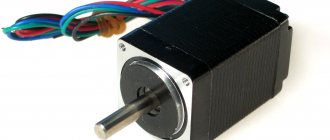Switching devices or simply contacts are very widely used in various electrical and radio equipment. In order to improve operational properties, primarily the service life and reliability of the connection, magnetically controlled sealed contacts, called reed switches, were developed.
The first examples of such contacts appeared back in the 30s of the last century, and the first magnetically controlled contact was invented back in 1922 in St. Petersburg by Professor V. Kovalenkov, for which he was issued the USSR Copyright Certificate No. 466. The design of such a contact is shown in Fig. 1.
Such a contact is arranged as follows. Contacts 1 and 2, also made of soft magnetic material, are attached to the core 3 made of soft magnetic material through insulating spacers 5. When current is passed through coil 4, a magnetic field appears in core 3 and magnetizes contacts 1 and 2, which close. The contacts open when the current through the coil stops.
Rice. 1 Magnetic-controlled contact by Professor V. Kovalenkov
In fact, this was the very first magnetically controlled contact, only without a sealing shell. Such a contact was first placed in a sealing shell by the American engineer WB Ellwood only in 1936. In the seventies of the last century, reed switches reached their maximum development and were widely used in various electronic devices.
Currently, reed switches are used less intensively, since they have been “supplanted” by Hall sensors. But in some cases, reed switches have remained out of competition, which is due to ease of use, galvanic isolation from the power source, and the properties of a “dry contact”; therefore, reed switches are still used in various circuits and devices.
In cases where high reliability and durability of the switching element are required, reed switches are simply irreplaceable. As an integral part, reed switches are included in the designs of various sensors, electromagnetic relays, especially low-current ones, as well as position switches and some other devices.
What is a reed switch
A reed switch is a type of relay. The word "reed switch" is an abbreviation for the words "sealed contact". This is the main feature of this electronic device.
Sealed contact
Conventional electromagnetic relays have movable and fixed metal contacts. There is an air gap between them. When they close or open, an electric arc is formed. The air between the contacts acts as a conductor. Arcing damages the contacts and shortens the life of the relay.
A reed switch works in a similar way, but the terminals are in an inert gas environment. For this reason, arc ignition is not possible. Consequently, the reed relay contacts do not burn out, which increases the service life of the electronic device.
Household repair No. 1
Choose reliable craftsmen without intermediaries and save up to 40%!
- Fill out the application
- Receive offers with prices from masters
- Select performers by price and reviews
Post a task and find out prices
A reed sensor is a device designed to improve the technical properties and service life of electrical equipment contacts. You can connect it either with your own hands or with the help of professional technical services. Do-it-yourself connection, in the absence of appropriate competence, can take a lot of time or even lead to an unsuccessful attempt to install the reed switch. Using the Yudu service, you can quickly find and order professional services for connecting a reed switch relay: just leave a request on the website or select the most suitable offer from the catalog of performers.
Part device
The reed switch sensor looks like a small glass tube made of green translucent glass. There are wire leads on both sides. They allow you to solder the part to the board or connect wires to it. There are also three-pin models.
Inside the glass tube there is a cavity with an airless environment. The cavity contains contacts that are connected to the terminals of the device located outside. This part does not have semiconductors. Therefore, it can operate on alternating current.
Reed switches are quite varied in size. Small models have a length of 10-15 mm. The larger ones are the size of a palm.
This is interesting! There is a tendency to reduce the overall dimensions of reed switches. In 2022, the American company put into mass production a part with a tube length of 4.01 mm. In 2005, the Japanese also had achievements in this area and announced the production of a prototype with a flask length of 2 mm. However, these details have not yet received wide distribution.
Types of contacts
Reed switches have a classification similar to other types of relays. In terms of contact status, the following models exist:
- With normally closed contacts. If you bring a magnet close, the device's terminals open.
- With normally open contacts. If you bring a magnet close, the terminals will close.
- With changeover contacts. If the magnet is nearby, one group of terminals is closed. If the magnet is removed, the first group will open, but the second will close.
According to the contact arrangement, reed switches are divided into 2 types:
- With dry contacts. Made of solid metal.
- With wetted contacts. There is a drop of mercury inside. It reduces the contact resistance of the device and eliminates contact bounce.
From the point of view of the internal environment, there are 2 types of devices:
- Inside the tube is an inert gas (usually nitrogen).
- A vacuum environment is created inside. This reed switch is used in high voltage circuits, including 220 volts and above.
Vacuum reed switch with mercury
Purpose, areas of application
Semiconductor devices (Hall sensors) are increasingly used in switching electronic devices. However, the reed switches of some devices can withstand competition with them, despite the lag in technical parameters:
- connections hidden by the surface of the bulb guarantee safe operation in explosive areas;
- in devices operating under water, in places with a humid climate;
- in alarm systems based on position control;
- determining the elevator position at the current moment;
- keyboard of industrial devices for reliable and long-term operation;
- some samples of television and radio equipment, medical devices and other areas of technology.
Operating principle of a reed switch
The contacts are activated under the influence of a magnetic field. Its source is usually a permanent or controlled electric magnet.
The field from the magnet easily penetrates through the glass into the sealed cavity. Once inside, it interacts with the metal contacts of the device.
The magnetic field sets them in motion, thereby closing or opening the electrical circuit connected to the terminals of the part. Therefore, to check the functionality of such a relay, it is enough to bring any magnet to it.
Operating principle of a reed sensor
Closing and opening contacts requires some magnetization time. It is measured in units of milliseconds, so in practice it is usually not taken into account. In most cases, it is acceptable to assume that the reed switch is triggered immediately when it enters a magnetic field.
Technical parameters of choice
When choosing, you should take into account a number of technical characteristics of this device. The main ones include:
- current switching capacity;
- maximum voltage;
- breakdown voltage of the gap between the contacts;
- contact resistance;
- maximum load power that can be connected to the terminals of the sealed contact;
- time of closing and opening of the device;
- field strength at which the reed switch will operate.
Additional Information! The contact resistance of contacts can increase as they wear out. It also depends on the strength of the magnetic field acting on the reed switch and its position in space.
Advantages
- A significant resource due to the protection of contacts from oxidation by atmospheric oxygen and extremely low friction during operation (more than a trillion cycles);
- Miniature size (better in compactness than relays with the same characteristics);
- It is possible to switch weak signals;
- They practically do not distort the signal with noise;
- Response speeds are higher than relays;
- High breakdown voltage;
- Tightness of the structure;
- No need for maintenance;
- The control and switching circuits are independent of each other and galvanically isolated.
How to operate a reed switch
Reed switches close (open) contacts when exposed to a magnetic field. The field source is usually a permanent or electric magnet.
If we are talking about a permanent magnet, then the reed switch is in a closed state when the magnet is nearby. If you move it to the side by 5-7 mm, the contacts of the device will open.
With an electric magnet, you don't need to move anything. The reed switch tube is located inside the electromagnet coil. When voltage is applied to it, a magnetic field is generated. It keeps the terminals closed. If the voltage is removed from the electromagnet, the field will disappear and the terminals will open.
Electromagnetic switch with reed switch
Reed switch control by means of a coil through which direct current is passed
This method is widely used in the design of reed relays with a small number of contact groups. One or more reed switches are placed in the hollow core of the housing on which the winding is wound.
Design elements of the reed relay RES-24
An example of such use is current protection sensors in electrical networks supplying equipment. The coils are wound with wire thick enough to handle the current loads used in the manufacturing process. If the current exceeds, the magnetic field disconnects the reed switch contacts, and the equipment is de-energized. The setting is carried out by moving the reed switch along the threaded connection inside the coil along the axis.
Advantages and disadvantages
Like any electronic components, reed switches have advantages and disadvantages. Advantages:
- increased wear resistance;
- compact overall dimensions relative to conventional relays;
- absence of intrinsic noise and signal distortion;
- contacts are isolated from environmental dust.
Flaws:
- inability to work in conditions of extraneous magnetic fields;
- spontaneous opening and sticking of contacts at high currents;
- fragility, vibration intolerance;
- increased contact bounce due to their elasticity.
Connecting a reed sensor
The documentation supplied with the sensors provides comprehensive information on how to connect the reed switch.
For the operation and safety of the sensor, the part of the relay that generates the magnetic field is mounted on the moving part of the structure. The reed switch itself is attached to a permanently installed element of the structure or building.
The moving part is tightly adjacent, influencing the magnetic field of the coil on the contact network of the reed switch and thereby closing the electrical circuit. The system sensor informs about the correct functioning of the system. As soon as the coil located on the moving part stops influencing the sensor, the network opens and the automation reports a violation of the integrity of the system.
According to the installation method, sensors are:
- hidden fastening;
- external fastening.
Depending on the physical properties of the surface on which the reed switch is connected, there are:
- sensors for mounting on steel structures;
- sensors mounted on magnetically passive structures.
When installing a reed relay, you must remember some installation features:
- It is recommended to avoid location near ultrasound sources. It can have a negative impact on the sensor parameters.
- Avoid placing the device near a source of extraneous magnetic field.
- Protect the sensor bulb from impacts and damage. Otherwise, the gas will evaporate, contact will be broken, and the cores will quickly become unusable.
Reed switches cannot switch high currents due to the low power of the cores. Therefore, they cannot be used to turn high-power electrical devices on and off.
They are included in a low-power switching circuit to control relays that control equipment.
Explanation of markings
On electrical circuit diagrams, the reed switch is designated as a circle with normally open or normally closed contacts. The symbol resembles an ordinary button surrounded by a circle.
In the technical documentation, the reed switch is marked with letters and numbers. For the designations of most such devices, the following is true:
- 1st character – name of the part (MK – magnetically controlled contact);
- 2nd symbol – type of contacts (A – normally open, B – normally closed)
- 3rd symbol – the letter “P” is indicated only on devices with mercury;
- 4th character – length of the flask in millimeters (two-digit number);
- 5th character – functional feature of the device (1 – low and medium power, 2 – high power);
- The 6th character is the serial number of the development.
Designation system for reed relays
For example, you can disassemble the MKA-14103 model:
- MK – magnetically controlled contact;
- A – closing;
- the letter “P” is missing, which means without mercury;
- 14 – flask length 14 mm.
- 1 – low or medium power;
- 03 – development order (useless in practice).
Simple examples of everyday use
The reed switch is a simple part, so radio amateurs willingly assemble various devices on it with their own hands. Below are 3 popular solutions that are implemented using this part:
- Signaling. A secret magnet is attached to the door (it is advisable to use neodymium). A door reed switch is installed on the cladding. It is necessary to fasten it so that when the passage is open, the reed switch terminals are open, and when the passage is closed, they are closed. As a result, the door status is converted into an electrical signal. It can also be converted into an alarm sound.
- Homemade on-board computer for a bicycle. In this case, the magnet is installed on the wheel or drive sprocket of the bicycle. The reed switch is fixed on the frame of the “iron horse”. The higher the speed of the bicycle, the more often the magnet comes into close proximity to the part. Using a microcontroller circuit, these pulses can be converted into the current speed of the bicycle or the distance traveled per day can be calculated.
- Use as a limit switch on moving mechanisms (for example, on automatic gates).
Additional Information! The electronics industry also produces reed switches for security alarms. Such amateur-class devices include the wireless door opening sensor ALD01. Professional systems use mortise reed switches, which do not attract attention. They allow you to hide the fact that the detector is operating.
The operating principle of a reed switch is based on its interaction with a magnetic field. If you bring a magnetized object to the reed switch, its terminals will close. And if you place this part in the field of a controlled electric magnet, you will get a relay with increased wear resistance.
This device should be selected based on the maximum permissible current and voltage. At the same time, it is necessary to take into account the operating conditions. Devices such as an electromagnetic intercom lock located near the reed switch can affect its operation.
